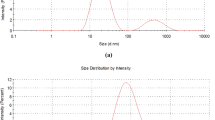Abstract
In the present work, the preparation of olive oil w/o nanoemulsions was studied using non-ionic surfactants (Tween 20, Span 20) without the addition of a co-surfactant. Different olive oil endogenous compounds with an amphiphilic character (gallic acid, apigenin, quercetin, and trans-cinnamic acid) were dispersed into the aqueous phase, and their impact on the nanoemulsions stability and properties ability was determined. The stable nanoemulsions were presented in pseudo-ternary phase diagrams (oil–aqueous phase–surfactant) for each surfactant and endogenous compound. The nanoemulsions properties were evaluated in relationship to compositional components. The results of this study concluded that stable w/o olive oil nanoemulsions without use of a co-surfactant were obtained and moreover, the most efficient type of emulsifier and its ratio of addition in the system were determined. The incorporation of olive oil endogenous compounds resulted into more stable emulsions. In particular, gallic acid was proven to be the most efficient compound since it enhanced the emulsion properties prolonging simultaneously the emulsions’ stability.









Similar content being viewed by others
References
Ambrosone, L., Cinelli, G., Mosca, M., & Ceglie, A. (2006). Susceptibility of water-emulsified extra virgin olive oils to oxidation. Journal of the American Oil Chemists’ Society, 83, 165–170.
Azeem, A., Rizwan, M., Ahmad, F. J., Iqbal, Z., Khar, R. K, Aqil, M., & Talegaonka, S. (2009). Nanoemulsion components screening and selection: a technical note. AAPS PharmSciTech, 10, 69–76.
Bouchemal, K., Briancon, S., Perrier, E., & Fessi, H. (2004). Nano-emulsion formulation using spontaneous emulsification: solvent, oil and surfactant optimization. International Journal of Pharmaceutics, 280(1–2), 241–251.
Chaiyasit, W., Elias, J. R., McClements, D. J., & Decker, E. A. (2007). Role of physical structures in bulk oils on lipid oxidation. Critical Reviews in Food Science and Nutrition, 47, 299–317.
Claesson, P. M., Blomberg, E., & Poptoshev, E. (2004). Surfaces forces and emulsion stability. In S. E. Friberg, K. Larsson, & J. Sjöblom (Eds.), Food emulsions (4th ed., pp. 259–297). New York: Marcel Dekker, Inc.
Di Mattia, C. D., Sacchetti, G., Mastrocola, D., & Pittia, P. (2009). Effect of phenolic antioxidants on the dispersion state and chemical stability of olive oil O/W emulsions. Food Research International, 42, 1163–1170.
Di Mattia, C. D., Sacchetti, G., Mastrocola, D., Sarker, D. K., & Pittia, P. (2010). Surface properties of phenolic compounds and their influence on the dispersion degree and oxidative stability of olive oil O/W emulsions. Food Hydrocolloids, 24(6–7), 652–658.
Garti, N. (1999). What can nature offer from an emulsifier point of view: trends and progress? Colloids and Surfaces A: Physicochemical and Engineering Aspects, 152(1–2), 125–146.
Garti, N., Spernath, A., Aserin, A., & Lutz, R. (2005). Nano-sized selfassemblies of nonionic surfactants as solubilization reservoirs and microreactors for food systems. Soft Matter, 1, 206–218.
Ghosh, V., Mukherjee, A., & Chandrasekaran, N. (2013). Ultrasonic emulsification of food-grade nanoemulsion formulation and evaluation of its bactericidal activity. Ultrasonics Sonochemistry, 20, 338–344.
Kruglyakov, P. M. (2000). Hydrophile-lipophile balance of surfactants and solid particles: physicochemical aspects and applications. Amsterdam: Elsevier.
McClements, D. J. (2002). Colloidal basis of emulsion color. Current Opinion in Colloid and Interface Science, 7, 451–455.
McClements, D. J., & Rao, J. (2011). Food-grade nanoemulsions: formulation, fabrication, properties, performance, biological fate, and potential toxicity. Critical Reviews in Food Science and Nutrition, 51, 285–330.
Papadimitriou, V., Tzika, E. D., Pispas, S., Sotiroudis, T. G., & Xenakis, A. (2011). Microemulsions based on virgin olive oil: a model biomimetic system for studying native oxidative enzymatic activities. Colloids and Surfaces A: Physicochemical and Engineering Aspects, 382(1–3), 232–237.
Polychniatou, V., & Tzia, C. (2014). Study of formulation and stability of co-surfactant free water-in-olive oil nano- and submicron emulsions with food grade non-ionic surfactants. Journal of Oil & Fat Industries, JAOCS, Journal of the American Oil Chemists’ Society, 91(1), 79–88.
Rashidi, L., & Khosravi-Darani, K. (2011). The applications of nanotechnology in food industry. Critical Reviews in Food Science and Nutrition, 51, 723–730.
Sheela, A. Y., Dinesh, S., & Sushilkumar, P. (2012). Influence of components of nanoemulsion system for transdermal drug delivery of nimodipine. Asian Journal of Pharmaceutical and Clinical Research, 5, 209–214.
Sonneville-Aubrun, O., Simonnet, J. T., & L’Alloret, F. (2004). Nanoemulsions: a new vehicle for skincare products. Advances in Colloid and Interface Science, 108, 145–149.
Sotiroudis, T. G., Sotiroudis, G. T., Varkas, N., & Xenakis, A. (2005). The role of endogenous amphiphiles on the stability of virgin olive oil-in-water emulsions. JAOCS, Journal of the American Oil Chemists’ Society, 82(6), 415–420.
Tang, S. Y., Manickam, S., Wei, T. K., & Nashiru, B. (2012). Formulation development and optimization of a novel Cremophore EL-based nanoemulsion using ultrasound cavitation. Ultrasonics Sonochemistry, 19, 330–345.
Ushikubo, F. Y., & Cunha, R. L. (2014). Stability mechanisms of liquid water-in-oil emulsions. Food Hydrocolloids, 34, 145–153.
Van der Hoeven, P. C., & Lyklema, J. (1992). Electrostatic stabilization in non-aqueous media. Advances in Colloid and Interface Science, 42, 205–277.
Varzakas, T., Polychniatou, V., & Tzia, C. (2014). Mixing-emulsions. In T. Varzakas & C. Tzia (Eds.), Food process engineering (pp. 181–252). CRC Press: Greece.
Zetasizer Nano Series User Manual. (2004). Malvern Instruments Ltd, United Kingdom, Man0317 2.1, 5.5–5.6.
Author information
Authors and Affiliations
Corresponding author
Rights and permissions
About this article
Cite this article
Polychniatou, V., Tzia, C. Study of the Emulsifying Ability of Olive Oil Endogenous Compounds in Co-surfactant Free Olive Oil w/o Nanoemulsions with Food Grade Non-ionic Surfactants. Food Bioprocess Technol 9, 882–891 (2016). https://doi.org/10.1007/s11947-015-1668-8
Received:
Accepted:
Published:
Issue Date:
DOI: https://doi.org/10.1007/s11947-015-1668-8




